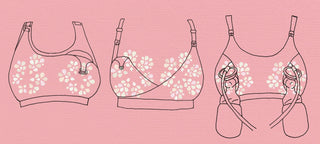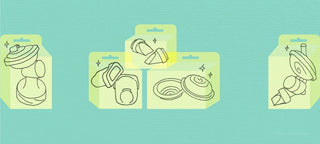Take the mystery – but by no means the magic! – out of milk production.
Skip the intro, I want the info
This intro contains references to an individual’s experience of twin and premature birth. If you are sensitive to this content you can skip to the main article here
The midwife helped Jade by hand expressing her colostrum as soon as she was wheeled into the recovery room following the birth of her twin girls. Born prematurely, they had been whisked off to the NICU for the start of what would be a three-and-a-half-week stay.
After being taken over to see her daughters nestled in their humidicribs, Jade was instructed on how to use the hospital's pump in readiness for her breast milk coming in. Even though its flanges were WAY too big for her (an all-too-common story!) she soon began pumping every three hours to let her body know that yes, she would like all the milk now please.
Years prior, while studying Health Science at university, Jade learned what a single drop of breastmilk looked like when viewed through a microscope. So alive with all the proteins for cell building, fats for brain development and immune supporting immunoglobulins was that single drop, that Jade knew breastfeeding, for her, would be absolutely non-negotiable.
Despite Jade's strong motivation and around-the-clock pumping efforts well beyond the girls’ time in the NICU, she was never quite covering their milk needs. This soon led to a sense that she was chasing her tail, trying to keep up. Adding to the complexity, the twins both had reflux, affecting their ability to keep milk down. Jade also discovered they were sensitive to dairy and soy, which made sourcing appropriate donor breast milk more difficult.
With relentless determination, Jade sought the ongoing support of an International Board Certified Lactation Consultant (IBCLC). With their incredible guidance – and with varying degrees of success – she began treatments of Domperidone, tried a supply line, refined her flange sizing, and started using a (sanity-saving) wearable pump. On top of that, she tried six different types of formula before finding one the girls could tolerate as a supplement to her breast milk. By ten months postpartum, Jade weaned the girls and gave her body (and mind!) a well-deserved break following all her feeding efforts.
Once 'out of the woods' from her first year of motherhood, Jade had a newfound appreciation for her body. Her breastfeeding goals had been necessarily realigned, but Jade was still curious. Could she use pumping to relactate after a two-month break? With the benefits of her now mature milk on offer (higher concentrations of fats, proteins, digestive and antibiotic enzymes and immunoglobulins), she felt her twins had everything to gain by her trying.
In spite of the massive challenge at hand, Jade’s huge efforts – combined with medication and IBCLC support – eventually proved successful! Jade felt thrilled to once again give her girls whatever she was able to pump into their bottles each day, knowing what power and goodness was contained in just a single drop of her breast milk.
Breast milk is legit magic. Protective, nourishing, with absolutely dialled in responsiveness. But how exactly do you make it? And how do you maintain a supply that meets your breastfeeding goals?

Breastfeeding is a powerful and enriching extension of the intimate connection that your body has already long established with your baby. Here we'll take you through how breast milk is produced by your body, what influence you can exert on the process and what to know about the stages involved, from early milk to maintaining an established supply. Youha's in-house International Board Certified Lactation Consultant (IBCLC) Kate joins us to share what to know about the potential factors affecting breast milk production.
So, how is breast milk produced by my body?
During pregnancy, the hormones driving all your bodily changes are getting to work remodelling the sweat glands in your boobs into a milk factory and storage facility. Your milk ducts expand their network, branch out, and at each end, form little pockets (alveoli) which have a milk-secreting lining. From here, milk is squeezed into the common duct of each cluster (lobule) on its way to drain through your nipple pores. In pregnancy, colostrum is in fully fledged production mode from as early as 15 weeks. No wonder sore boobs can be an early sign of pregnancy!

What is colostrum?
Positively teeming with your immune defences (antibodies), the main purpose of colostrum, aka 'early milk', is to line your newborn's teeny stomach. This offers them protection against pathogens, enabling you to continue to share via your milk the passive immunity they enjoyed from you in utero. The presence of colostrum from early on in your pregnancy can be vital if you happen to have a premature or caesarean birth, where immediate post-birth contact with your newborn may be disrupted. Under the supervision of their medical team, some even choose to express colostrum at the end of their pregnancy so they have it on hand.
When does breast milk come in?
Following birth, the sudden drop in the pregnancy hormone progesterone allows your body to switch gears and ramp up into milk production mode. This sees your milk changing from thick colostrum to ‘transitional milk’, which starts coming in around days three to five. After transitional milk comes in, breastfeeding or pumping is needed to stimulate any further production and begin building a rapidly increasing breast milk supply for your baby.

What does it mean to establish a supply?
Establishing your supply of breast milk involves ongoing stimulation in the form of regular milk removals. If all is going well, your baby will naturally regulate your supply as your body will continually replace the amount of milk they’ve drunk (aka demand and supply). Additionally, as your baby grows, the composition of your milk adapts in response to their changing needs. For those who may not be able to feed directly at the breast, or those who make the choice not to, a breast pump can support you to express milk to meet your baby's needs similarly.
How long will it take to establish my supply?
Breast milk supply will typically regulate – aka establish – and become more reliable and robust between six to twelve weeks postpartum.
How much milk does my baby need?
When you look at the rate of expected growth of your baby, you might easily expect that you'd be continually building an ever-increasing supply of milk throughout your time breastfeeding, however this is not the case! In reality, the biggest increase in production takes place in the first two weeks and then shifts into maintenance mode after about a month. From there, the amount of milk your baby needs will remain relatively consistent until around nine months, when solid foods and water intake lessen your baby’s reliance on your milk for hydration and nutrition.

How long should I breastfeed for?
Only you can answer this age-old question – by following your gut, your experience, and your timeframe. You do you.
There are so many undeniable health benefits for your baby that the WHO recommendation for breastfeeding is from birth until age two as a general guide. Beyond the first six to twelve months, your amazing body continues to adjust and your milk becomes richer in protein, fat, calories, antibacterial and digestive enzymes and most importantly immune-boosting antibodies even as your little one’s daily requirements and number of feeds reduce. Even a small daily bottle or feed is like giving your toddler a bespoke multivitamin supplement, immunisation shot and brain-boosting superfood. See why they call it liquid gold?!

IBCLC Kate had these points to note about potential factors affecting breast milk production:
The early bird catches the worm
Milk production rates naturally fluctuate during the day. Most mothers will experience a higher volume of milk in the early morning hours as the milk making hormone, prolactin, peaks overnight. Though milk volume in the evening is lower, the milk is higher in fat and serotonin (nature's way of lulling your little one to sleep!).
Knowledge is power: Your Magic Number
The super-helpful Magic Number theory describes how you can keep your milk production steady as long as you consistently fit YOUR minimum (magic) number of feeds or pumping sessions into each 24-hour cycle.
Get hands on
If you've got some spare time on your hands while pumping, put them to good use! A gentle hands on massage when pumping has been shown to improve milk output by a whopping 48%. Use your hands to massage your breasts when pumping or direct feeding. For a demonstration of the correct technique, you can always ask your Lactation Consultant, or view this reel on our instagram.
A note for casual pumpers
If you are usually feeding directly at the breast and then go to use a pump, your body may need some time to adjust and respond well to the different sensation. To encourage your letdown during a direct breastfeed your baby hacks your happy hormones with their suckling and cuddles, so don't be surprised if a pump doesn't have quite the same knack! To learn how you can support your letdown while pumping, read the advice on our how to use a breast pump like a boss blog.
Wrap-up: How breastmilk is produced

With so much change happening in your body, mind and emotions as you usher your baby from your womb into your arms, the pressure to establish breastfeeding can feel intense! Steady yourself with the inside knowledge of how you can support your body to perform this act of enrichment. Knowing how your body works can help you to realise your breastfeeding goals as you seek to establish your supply.
Share this blog to reveal the inner workings of breast milk production – our body's coolest magic trick – and remind others in your life of the ways in which they can support their milk production in pursuit of their breastfeeding goals.
Thanks for sharing Jade!
Our gorgeous mate Jade is a BHSc Naturopath, podcaster, mama of twins, former pumper, and one of the faces of the Embody wearable breast pump! (what a gem!)
For encouragement and support, you can visit, follow and connect with Jade on Instagram at jadewalkerhealth
Thanks for your advice Kate!
Our in-house expert Kate is a Registered Nurse and International Board Certified Lactation Consultant with over 8 years of experience in both Community Paediatric and Neonatal Nursing (damn, girl!)
Kate is working with Youha in our joint aim to educate, empower and support you to meet your pumping/feeding goals.
You can view Kate's Bio in our Expert Directory to learn more.
Just a friendly reminder that this blog provides general information and is not intended and should not be considered, nor used as a substitute for, medical advice, diagnosis or treatment. If in doubt, please always consult your healthcare professional.




